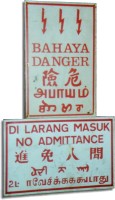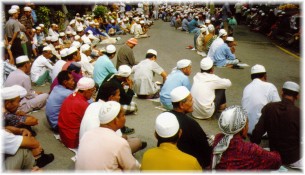 Whereas much of Parameswara's path to Malacca was charted by aggression
and flight, the growth of Malacca was based on his ability to negotiate
relationships that would make the port a conduit for trade from China to
India and places between. He negotiated for China's trade and protection
from the threat posed by the Sukothai kingdom with the great Chinese admiral,
Cheng Ho.
Whereas much of Parameswara's path to Malacca was charted by aggression
and flight, the growth of Malacca was based on his ability to negotiate
relationships that would make the port a conduit for trade from China to
India and places between. He negotiated for China's trade and protection
from the threat posed by the Sukothai kingdom with the great Chinese admiral,
Cheng Ho.  In marrying a Muslim princess from across the Straits of Malacca in Pasai on Sumatra, he tacitly
brokered business from Muslim traders in Southeast Asia. Finally, he increased
trade links with India, especially Gujerat.
In marrying a Muslim princess from across the Straits of Malacca in Pasai on Sumatra, he tacitly
brokered business from Muslim traders in Southeast Asia. Finally, he increased
trade links with India, especially Gujerat.
The Colonial era of Malacca began when D'Albuquerque led the Portuguese in a successfully attack on Malacca. The port's long, preciptous decline
began at this time too. In 1641 the Dutch would take
Malacca from the Portuguese. The British quietly took control of Malacca
in 1824. What remains of the historical colonial architecture of Malacca
dates from the Dutch period with some modifications made under the British.
There is something annoying about a town, city, or country which has lost
its importance and monuments to that importance, but not its historical
renown. Melaka, as it is now known, is still a quaint city, but it had lost
its commercial vitality centuries ago. Today its importance lies primarily
with its center as a port for lumber from Indonesia* and as a tourist attraction
where architectural reminders of the Dutch colonial period can still be
seen (* a sailor aboard one vessel yelled a "hello misterrrr" in distinctive
Javanese style). The European colonial period is probably what draws most tourists to modern Melaka. A close
second my be the interest generating around the historical presence of ethnic Chinese dating back to the marriage of the Sultan of Malacca to a Chinese
Princess several centuries ago. Where else in Southeast Asia can you see a Daoist Temple that is more than 200 years old?

 |
 |
Traveling through Malaysia, my attention was drawn to the fact that there were so
many ethnic Chinese Malaysians and that they seemed to dominate the life of the larger
towns and cities. Still, while you might see Chinese characters on walls, signs, and columns
associated with specific businesses, Chinese has been kept separate from the country's wider culture as
if it were oil in a pool of water.
It's probably my frustration over the limits of permeating the surface of a foreign country without
comprehending the local language that makes me so fascinated with languages and the peculiarities I can
discern without being able to communicate more than a simple idea with the locals. Acknowledging my shortcomings
first, I would like to share the most obvious of what I did learn about the language spoken in Malaysia, Bahasa Melayu.
At the most basic level, adjectives follow nouns and the plural form of a word is often one word
repeated. Bahasa Melayu has been perceptibly influenced by historic trade relations, the colonial experience, and the post-
colonial experience.

Bahasa Melayu shares some 60,000 words with Bahasa Indonesia. The government
of Indonesia classifies Malay as a foreign language. They both share terms
from the historical influence of Indian and Arab merchants. The term "Bahasa"
is Sanskrit for "language." Both Bahasa Indonesia and Bahasa Melayu share
terms like kuliah agama, translated as a sermon, which have origins
in Indonesia (kuliah) and Sanskrit (agama). The shared historical
influence of Islam brought by Arabs centuries ago has liberally peppered
Malay and Indonesian with Arabic terms such as inai (henna, but
also used to refer to the practice of newly married couples dying their
hands and feet with henna), khutbah (another term for a sermon),
and Jumaat (Friday). Arabic has also influenced the names of Malay
people. Salim Bin Ya is Arabic for "Salim the son of Ya" while "David A/L
Muthu" and "Maziah BT Ya" are linguistically Malay variants of the same
having the literal meaning of "David anak (child) lelaki
(male) of Muthu" and "Maziah binti (daughter) of Ya." This is as
close as you may get to a surname in Muslim Malaysia. Neither David nor
Maziah are expected to change any part of their respective names after
they marry.
 |

Kuliah Agama, Kota Bharu |

The differences in the way Indonesian and Malaysian are spoken have
more recent origins in Western Colonialial era of the Malay Peninsula and islands that now comprise
the two states. Kebaya (traditional attire for Malay women) is a
term shared by both which was adopted from Portuguese. Dutch words and
ways of spelling Indonesian place names distinguish Indonesian from the
English colonial past of what is now Malaysia. In Indonesia, we learned
that it is fashionable to ask for bottled water by the dominant brand name
"Aqua." In Malaysia, the term for bottled water is "mineral." Malaysians
have done a phenomenal job of simplifying the spelling of English words:
ekspres bas (expres bus), mini foto servis, bas sekolah
(school bus), telefon (telephone), fonkads, kompleks
(complex), ais krim (ice cream), kolej (college), and taksi
(taxi).

At least two English words have their etymological source in colonial Malaya.
"Amok" comes from the Malay amuk: to go beserk, run amuck;
or to rage violently. Boogeyman originates from the Bugis of Celebes (Sulawesi)
whose fierce fighting ability against both the British and Malays in the
Straits Settlements had an obviously strong influence on those who returned
to the West.

Surprisingly, modern Malaysians still have difficulty with spelling
some Malay words. Baru is the modern spelling of "new", but the traditional
city in the north of Peninsular Malaysia, known as "New City" is spelled
"Kota Bharu"; the spelling of the city known as "New
Mountain" which is adjacent to Singapore is "Johor Bahru";
and a third city's name is spelled Wakaf Baharu (Wakaf
Baharu cannot be translated neatly into English, but has the general meaning
of a new place that has been donated for religious or community use).

The absence of Chinese linguistic influence upon Bahasa Melayu reveals something of the historic enmity directed to
this one particular foreign group.

Kuala Lumpur. 25 year-old Nor'aishah Bokhari claims
that her brother and father along with three unidentified men abducted
and took her to an aunt's house in Johor. Once there, her family made her
listen to sermons by Islamic teachers everyday and forced her to undergo
rituals by witch doctors. Why did they do this? Nor'aishah renounced Islam
so that she could marry her Chinese Christian boyfriend. Two policemen
are purported to have physically detained Nor'aishah's boyfriend during
her kidnapping. Commenting about Nor'aishah's decision to convert to Christianity,
an official of the ruling United Malays National Organization in charge
of religious issues said, "This issue is serious because it involves the
dignity of Islam." A minister in the Prime Minister's Department was reported
to have said, "If a woman desires to marry a non-Muslim, she should urge
the man to embrace Islam, and not vice-versa."
Nor'aishah escaped and she and her boyfriend went into hiding. In a
20-page complaint filed with the High Court, she stated, "I love my family
very much but how can I continue loving them after what they have done
to me and my boyfriend...they are hunting us like deer."
Meanwhile, Nor'ashah Bokhari's family has filed kidnapping charges against
her boyfriend.
[South China Morning Post, January 27, 1998]

